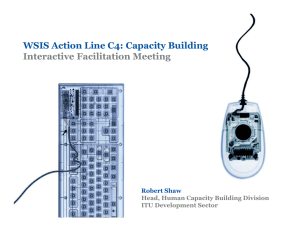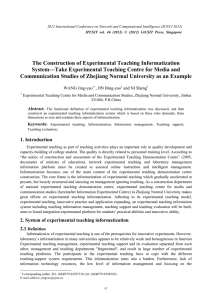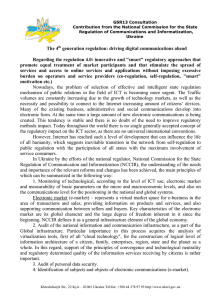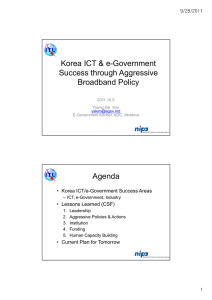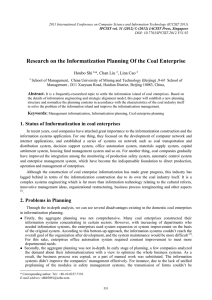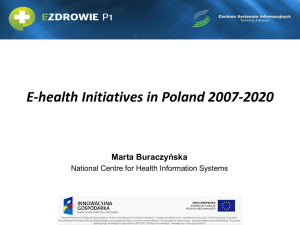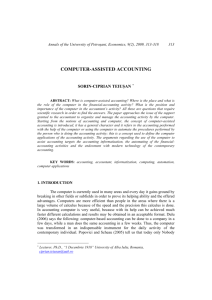Research Journal of Applied Sciences, Engineering and Technology 5(24): 5527-5533, 2013 ISSN: 2040-7459; e-ISSN: 2040-7467
advertisement
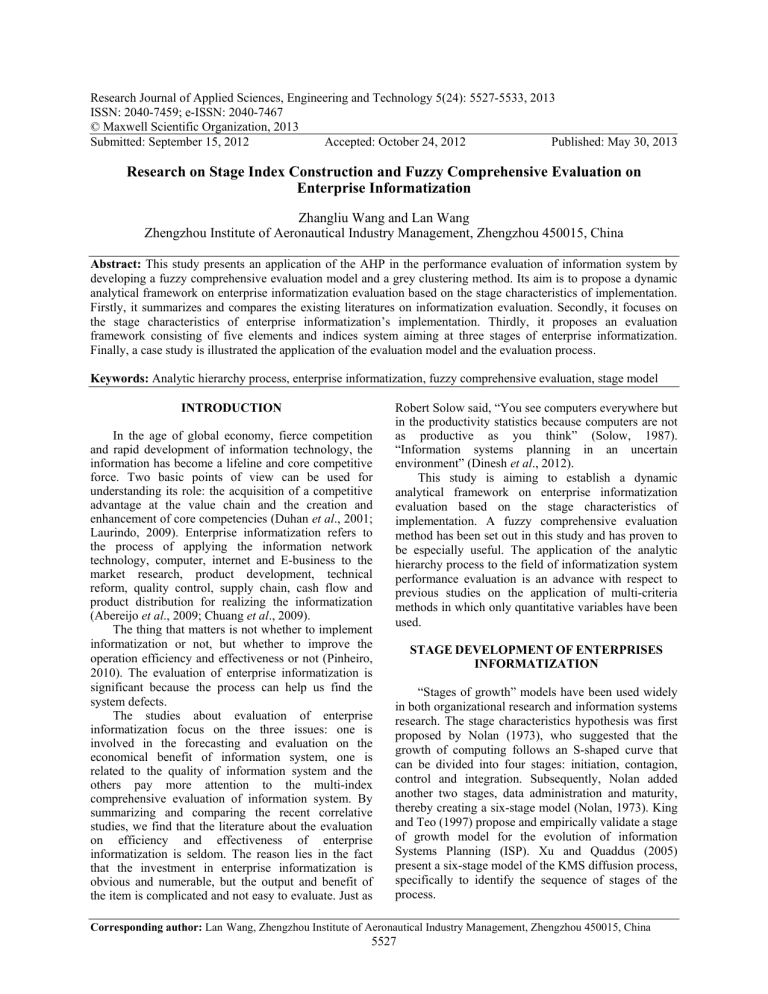
Research Journal of Applied Sciences, Engineering and Technology 5(24): 5527-5533, 2013
ISSN: 2040-7459; e-ISSN: 2040-7467
© Maxwell Scientific Organization, 2013
Submitted: September 15, 2012
Accepted: October 24, 2012
Published: May 30, 2013
Research on Stage Index Construction and Fuzzy Comprehensive Evaluation on
Enterprise Informatization
Zhangliu Wang and Lan Wang
Zhengzhou Institute of Aeronautical Industry Management, Zhengzhou 450015, China
Abstract: This study presents an application of the AHP in the performance evaluation of information system by
developing a fuzzy comprehensive evaluation model and a grey clustering method. Its aim is to propose a dynamic
analytical framework on enterprise informatization evaluation based on the stage characteristics of implementation.
Firstly, it summarizes and compares the existing literatures on informatization evaluation. Secondly, it focuses on
the stage characteristics of enterprise informatization’s implementation. Thirdly, it proposes an evaluation
framework consisting of five elements and indices system aiming at three stages of enterprise informatization.
Finally, a case study is illustrated the application of the evaluation model and the evaluation process.
Keywords: Analytic hierarchy process, enterprise informatization, fuzzy comprehensive evaluation, stage model
INTRODUCTION
In the age of global economy, fierce competition
and rapid development of information technology, the
information has become a lifeline and core competitive
force. Two basic points of view can be used for
understanding its role: the acquisition of a competitive
advantage at the value chain and the creation and
enhancement of core competencies (Duhan et al., 2001;
Laurindo, 2009). Enterprise informatization refers to
the process of applying the information network
technology, computer, internet and E-business to the
market research, product development, technical
reform, quality control, supply chain, cash flow and
product distribution for realizing the informatization
(Abereijo et al., 2009; Chuang et al., 2009).
The thing that matters is not whether to implement
informatization or not, but whether to improve the
operation efficiency and effectiveness or not (Pinheiro,
2010). The evaluation of enterprise informatization is
significant because the process can help us find the
system defects.
The studies about evaluation of enterprise
informatization focus on the three issues: one is
involved in the forecasting and evaluation on the
economical benefit of information system, one is
related to the quality of information system and the
others pay more attention to the multi-index
comprehensive evaluation of information system. By
summarizing and comparing the recent correlative
studies, we find that the literature about the evaluation
on efficiency and effectiveness of enterprise
informatization is seldom. The reason lies in the fact
that the investment in enterprise informatization is
obvious and numerable, but the output and benefit of
the item is complicated and not easy to evaluate. Just as
Robert Solow said, “You see computers everywhere but
in the productivity statistics because computers are not
as productive as you think” (Solow, 1987).
“Information systems planning in an uncertain
environment” (Dinesh et al., 2012).
This study is aiming to establish a dynamic
analytical framework on enterprise informatization
evaluation based on the stage characteristics of
implementation. A fuzzy comprehensive evaluation
method has been set out in this study and has proven to
be especially useful. The application of the analytic
hierarchy process to the field of informatization system
performance evaluation is an advance with respect to
previous studies on the application of multi-criteria
methods in which only quantitative variables have been
used.
STAGE DEVELOPMENT OF ENTERPRISES
INFORMATIZATION
“Stages of growth” models have been used widely
in both organizational research and information systems
research. The stage characteristics hypothesis was first
proposed by Nolan (1973), who suggested that the
growth of computing follows an S-shaped curve that
can be divided into four stages: initiation, contagion,
control and integration. Subsequently, Nolan added
another two stages, data administration and maturity,
thereby creating a six-stage model (Nolan, 1973). King
and Teo (1997) propose and empirically validate a stage
of growth model for the evolution of information
Systems Planning (ISP). Xu and Quaddus (2005)
present a six-stage model of the KMS diffusion process,
specifically to identify the sequence of stages of the
process.
Corresponding author: Lan Wang, Zhengzhou Institute of Aeronautical Industry Management, Zhengzhou 450015, China
5527
Res. J. Appl. Sci. Eng. Technol., 5(24): 5527-5533, 2013
In general, the earlier application of the
information technology in enterprise management is
tactical level. With its extend to other fields, the
influence of information technology in enterprise
management will be strategic, which will be go from
the automation tools and the communication means,
decision support, to the change of organization structure
and business model. The process of enterprise
informatization’s implementation leads to the stage
characteristics of informatization level (Zhiping and
Jinyu, 2012).
In space, the application of information technology
is gradually from the department scope, the interdepartment scope to the outside organization, which
connects the enterprises with the environment. With the
broad application, information technology breaks the
horizontal limit, vertical limit and external limit, which
facilitate the sharing and transfer between the inside
with the outside of the organization. In epistemology,
people’s understand to the application of information
technology is based on the long-term practice, which is
a successive and developing process. So, the level of
informatization does not depended on how long it
progress, but how people know about it. The
understandings for the informatization and the actuality
of enterprises have an important influence on the effect
of the application of information technology. The stage
characteristics of informatization implementation have
an important influence on the construction of index
system.
AN EVALUATION FRAMEWORK FOR
ENTERPRISES INFORMATIZATION
In general, evaluation system consists of five
elements: evaluation objectives, evaluation principle,
evaluation index, evaluation criteria and evaluation
methods. As evaluation index is involved in the
evaluation items, it is an important part. As Fig. 1, this
study establishes an evaluation framework for
enterprise informatization based on informatization
level and stages. The evaluation process is as followed.
Appraise the alignment between information
planning and enterprise strategy: Today many
companies make large investments in Information
Systems (IS). Yet executives often question the
business-IS alignment, namely whether these
investments support their strategic objectives or
whether opportunities to exploit IS for competitive
advantage are being over looked (Henderson and
External Analys is
Opporunities and Threaten
Internal Analysis
Resource and Ability
Enterprise strategy
feedback
Inf. strategy
Bus iness Strategy
feedback
Inf. Level (Stage)
Bus iness System
feedback
feedback
Evaluation system
IS
Performance
Evaluation
Inf. subsystem
Evaluation object
Index system
evaluation criteria
evaluation method
Fig. 1: Evaluation framework for enterprise informatization
5528
Res. J. Appl. Sci. Eng. Technol., 5(24): 5527-5533, 2013
Stage Ⅰ
Primary
Informationization
Primary
Informationization
Index System
Stage Ⅱ
Secondary
Informationization
Secondary
Informationization
Index System
Stage Ⅲ
Advanced
Informationization
Advanced
Informationization
Index System
Fig. 2: Index system based on stage evolvement of enterprise informatization
Venkatraman, 1993). It is necessary to appraise the
alignment between IS planning and enterprise general
strategy (Grover and Rajiv, 2007). The integration of
enterprise strategy and IS planning is helpful to
improve the alignment, which will make a support in
goal-orientation, resource allocation, organization
design and projects implement.
Appraise the present informatization level (stage):
Owing to the stage characteristics, there is one area
considered important for the right evaluation is the
present informatization level (stage). This study divides
the evolution of informatization into three stages:
primary informatization, secondary informatization and
advanced informatization.
•
•
•
distribution, financing, human resource and so on in
the enterprise, which connect the “information
island” together.
Advanced stage informatization: Advanced
informatization refers to the top-level application of
information technology in production, operation
and management. The application of information
system is from the single function to integrative
function. The enterprise accomplishes the high
integration of control and management by the
application of CIMS、CIPS, enterprise integration
and etc. The enterprise accomplishes the high
information of business service by the application
of B2B, B2C and E-business. Zero Inventories is
achieved by internet marketing and payment,
supply chain management system. The enterprise
begins to examine and evaluate the various costs
and benefits of IS, analyze and solve the problem
about the investment in IS in all round.
Primary
stage
informatization:
Primary
informatization refers to the low-level application
of information technology in production, operation
and management. Enterprise gradually applies and
fit CAD/CAM, PLC, DCS, OA/MIS, MIS, OA and
As the Fig. 2, the above three stage model for the
CAPP. Enterprises establish the data-base, which
evolution of information systems is used to analyze and
supply the decision-making with information. The
estimate the present level and development stage, which
enterprise is still not familiar with information
is helpful for the next evaluation project.
system and the attention to the economic
performance of information system is lacking.
Performance evaluation: Performance evaluation is
Secondary stage informatization: Secondary
involved in the selection of index system, evaluation
informatization refers to the high-level application
methods, economic income and non-economic benefit.
of information technology in production, operation
Time value, inflation and uncertain factors should be
and management. Managers pay more attention to
considered in the course of evaluation. This study next
the significance of information management and
proposes the different index system aiming to the
cost control. Enterprises gradually apply and fit
different stages of enterprise informatization.
CNC, FMS, PDM, APC and the application of
Small and medium enterprises can apply simple
some IT (such as: CAD, CNC, FMS, DCS, FC) is
method
and select the important indices. As for the
familiar. Enterprise basically accomplishes the
enterprise
in primary informatization stage, it can begin
function of MRP/II, ERP, SCM, CRM and DSS.
with
single
business and section to appraise the direct
Enterprises establish the data-base and carry out
financial
performance
owing to the low-level and small
data mining, which supply the decision-making
range
in
information.
As
for the enterprise in secondary
support for managers. The ICT (such as: data base
informatization
stage,
it
need to choice the indirect
and telecommunication) is used to collect, process,
index
step
by
step.
As
for
the enterprise in advanced
memory and transmit the data about production,
5529
Res. J. Appl. Sci. Eng. Technol., 5(24): 5527-5533, 2013
informatization stage, it focuses on the integrated index
and long-term performance of information system.
In evaluation methods, the performance evaluation
of information system is involved in multifactor (both
quantitative and qualitative variables, economic and
non-economic variables). In fact, some mature methods
are used, including: experts grading method, economic
model method, operations research methods, fuzzy
comprehensive method, statistical analysis method,
neural network method and etc.
Information feedback: According to close loop system
theory, as for an effectual evaluation system, a set of
effective and timely feedback mechanism is necessary
and helpful to adjust and perfect the information
strategy (or enterprise strategies). Furthermore, the
appraisal of evaluation methods, evaluation index and
evaluation process is indispensable. The evaluation
system is able to perfect by establishing a dynamic
mechanism
including
organization
learning,
organization experience accumulation and knowledge
management.
THREE STAGE INDEX SYSTEM DESIGNING
Because informatization is involved in various
process of enterprise management, the effect is directly
and indirectly reflected the value-added point of
enterprise management. When the evaluation index
system of information system is established, the key
operation process should be emphasized.
The index system of primary stage informatization:
In primary stage, the investment of informatization is
focused on the core value section, such as: CAD/CAM.
In the course of evaluation, related index should be
carefully selected on the basis of the different stage of
informatization. The index system of primary
informatization refers to the Table 1.
The
index
system
of
secondary
stage
informatization: In secondary stage, the investment of
informatization is focused on system integration and
information sharing. In the course of evaluation, the
indirect indices should be added and selected to reflect
Table 1: Index system of stage evaluation on enterprise informatization
Goal layer
First index layer
Second index layer
Referenced indices
Performance of
Production Index (u 11 )
Production capacity index; production quality index; production cost
Stage Ⅰ:
Enterprise
index; manufacturing cycle index; work-in-process turnover index
Primary Stage
Logistics Index (u 12 )
Days sales of inventory index; in-transit stock index; transportation
informatiz-ation
(U 1 )
expenses index; procurement lead time;
(U)
Marketing Index (u 13 )
Market shares index; marketing costs index; consumer repurchase;
market growth rate
R&D Index (u 14 )
R&D investment index; new production sales ratio; R&D management
cost index
Finance Index (u 15 )
Budget management index; process control index; expense index;
profitability index
Section Index (u 21 )
Above indices
Stage Ⅱ:
Economical Index (u 22 )
Production cost index; design cost index; marketing cost index;
Secondary Stage
financial cost index; management cost index
(U 2 )
Efficiency Index (u 23 )
Production efficiency index; R&d efficiency index; sale rise ratio;
finance management level
Financial Index (u 31 )
liquidity index; asset management index; debt-paying index;
Stage Ⅲ:
profitability index
Advanced Stage
Logistic and
Quality index; logistic cost index; technical Index; responsiveness
(U 3 )
technical Index (u 32 )
index
User-oriented Index (u 33 )
User satisfaction index; market shares index; customer loyalty and
profit per customer; consumer repurchase index
Learning and
HR exploitation index; management innovation index; enterprise
growing Index(u 34 )
growing index
Table 2: Scale of Preference between two elements
Preference weight
of importance
Definition
1
Equally important
3
Moderately important
5
Strongly important
7
Very strongly important
9
2,4,6,8
Reciprocals
Extremely important
Intermediates values
Reciprocals for inverse comparison
Explanation
Two activities contribute equally to the objective
Experience and judgment slightly favor one
Activity over another
Experience and judgment strongly or essentially favor one activity over
another
An activity is strongly favored over another and its dominance demonstrated in
practice
The evidence favoring one activity over another is of the highest degree
possible of affirmation
Used to represent compromise between the preference listed above
5530
Res. J. Appl. Sci. Eng. Technol., 5(24): 5527-5533, 2013
the effect of information system. The index system also
refers to Table 1.
Table 3: Random indices
N
3
4
5
RI
0.58
0.9
1.12
The index system of advanced stage informatization:
In advanced stage, the investment of information
system is focused on the comprehensive development
of IS and integrated management of data and
information. In the course of evaluation, the integrated
indices should be emphasized on the basis of the above
indices, including: financial index, logistic/technical
index, user-oriented index and learning/ growing index.
where, a i,j are pairwise comparisons from
alternatives/criteria given by the decision maker on a
verbal scale of nine levels (Table 2).
Check the consistency of the judgments.
Consistency Index (CI) is calculated as:
FUZZY COMPREHENSIVE EVALUATION
PROCESS OF ENTERPRISE
INFORMATIZATION
Index system: As shown in Table 1, this study
constructs the evaluation index system. There are three
layers and twelve evaluating indices in the system. The
system performance of enterprise informatization (U) is
the goal layer; the second index layer consists of three
indices: primary stage index (U 1 ), secondary stage
index (U 2 ) and advanced stage index (U 3 ); the third
index layer is the overall segments of the index layer,
including all the u ij .
Given the factors set of system performance of
enterprise informatization which will be evaluated is U.
Based on different attributes of the factors, U is divided
into u 1 , u 2 …, u m , namely, there are m subsets. The
evaluation comprises three categories and 12 factors.
U = {U 1 (primary stage index), U 2 (secondary
stage index), U 3 (advanced stage index)} = {u 11 , u 12 ,
…, u 34 }.
The weight for evaluation factors:
A = {A 1 , A 2 , A 3 } = {a 11 , a 12 , a 34 }
The weight is calculated by using fuzzy relation
equation and method of weight mean.
The procedure can be summarized as:
w1
w
1
w2
A = w1
w
n
w1
w1
w2
w2
w2
wn
w1
w1
wn
w2
wn
wn
w1
a11
a
21
=
a n1
CI =
6
1.24
7
1.32
8
1.41
9
1.45
10
1.49
λmax − n
n −1
where,
n
: dimension of the matrix
λ max : maximal eigenvalue
Generally, if CR is less than 0.1, the judgments are
consistent, so the derived weights can be used. The
formulation of CR is:
CR =
CI
RI
where,
CR : Consistency Ratio,
RI : Random Index (Table 3)
Saaty (1980) calculated the following random
indices: Come to a final decision based on the results of
this process.
Confirming the degree of subjection of index: When
system performance of enterprise informatization is
evaluated, it must be evaluated together by experts,
decision-makers and entrepreneurs based on the
comment set. The result is the degree of subjection
shown as matrix RB i :
RB = (r ij ) 3×5 , RB 1 = (r ij ) 5×5 , RB 2 = (r ij ) 3×5 , RB 3 =
(r ij ) 4×5 , r ij = d ij /d, d ij is the number of persons who gives
j level on the i-th index, d is the number of all the
experts.
THE EVALUATION RESULT
a12
a 22
an 2
a1n
a2 n
a nn
V = {V 1 (higher), V 2 (high), V 3 (middle), V 4 (low),
V 5 (lower)}
Result of the second level fuzzy comprehensive
evaluation: We can reduce the integrated evaluating
vector of ui according to the theory of fuzzy:
Establish priorities among the elements of the
hierarchy by making a series of judgments based on
n
m
pair wise comparisons of the elements.
Bi = Ai • PBi = ∨ a ij ∧ rij
j =1
k =1
where,
= (bi1 , bi 2 , , bim )(i = 1, 2,3, 4)
A = Comparison pair wise matrix
w 1 = The weight of element 1
w 2 = The weight of element 2
Result of the first level fuzzy comprehensive
w m = The weight of element m
evaluation: The fuzzy evaluating matrix of U is R*:
5531
i
Res. J. Appl. Sci. Eng. Technol., 5(24): 5527-5533, 2013
B1 b11 b21
B b
b
R * = 2 = 21 22
B3 b31 b 32
B4 b41 b42
Table 4: Pair-wise comparison matrix for
informatization performance
U1
U2
U3
U1
1
3
5
U2
1/3
1
4
U3
1/5
1/4
1
b1m
b2 m
b3m
b4 m
Every u i as one part of U, it reflects some attributes
of U. We can distribute the weight according to their
essentiality, namely, A* = (a 1 , a 2 , a 3 ). So we can get the
integrated evaluating vector: B* = A*·R* = (b 1 , b 2 ,…,
bm).
According to the principle of degree of maximum
membership degree, given B k = max (b 1 ,b 2 ,…,b m ), the
integrated evaluation vector is B k .
𝐴𝐴∗
the
three
stage
Priority vector
0.11
0.31
0.58
= (0.11 0.31 0.58)
As the same way, we can get:
= (0.32, 0.09, 0.15, 0.07, 0.37)
𝐴𝐴1∗
= (0.31, 0.26, 0.43)
A∗2
= (0.42, 0.29, 0.130.16)
A∗3
Fuzzy evaluation:
APPLICATION EXAMPLE
A1* • RB1 0.20 0.32 0.26 0.14 0.08
R = A2* • RB1 = 0.23 0.27 0.29 0.15 0.06
A3* • RB1 0.25 0.28 0.28 0.17 0.02
*
With the mathematical model and methods
mentioned above, we evaluate the information system
performance of one case enterprise. According to the
index system, we use the above evaluation model and
evaluation method.
𝐵𝐵∗ = 𝐴𝐴∗ 𝐵𝐵∗ = 𝐴𝐴∗ × R
0.20 0.32 0.26 0.14 0.08
B * = [0.11 0.31 0.58]× 0.23 0.27 0.29 0.15 0.06
0.25 0.28 0.28 0.17 0.02
Subjection degree of index: The expert group is made
up of 20 experts. The group evaluates every index in
term of comment set, hence we can get RB i :
0.20
0.25
RB1 = 0.15
0.30
0.20
𝐵𝐵∗ = (0.26, 0.28, 0.25, 0.16, 0.05) = 0.28=𝑉𝑉2
𝐵𝐵𝐾𝐾 = max (0.26, 0.28, 0.25, 0. 16,0.05) = 0.28 = 𝑉𝑉2
0.00
0.00
0.10
0.10
0.35 0.25 0.15 0.15
0.35
0.30
0.25
0.25
0.25
0.30
0.35
0.15
0.10
0.15
0.15
0.20
RESULTS AND CONCLUSION
0.15 0.30 0.35 0.20 0.00
RB2 = 0.30 0.35 0.20 0.10 0.05
0.25 0.20 0.30 0.15 0.10
0.35
0.20
RB3 =
0.15
0.20
0.25
0.35
0.25
0.20
0.25
0.25
0.35
0.35
0.15
0.20
0.15
0.20
0.00
0.00
0.10
0.05
Index weight: The domain experts confirmed the index
weight. We have verified the consistency of judging
matrix. The consistency is eligible, we receive
integrated judging matrix and calculate the weights.
Next, we give the fuzzy comparison matrixes of the
criteria level and sub-criteria level. For instance,
Table 4 shows the original fuzzy pair-wise comparison
matrixes for enterprise informatization evaluation.
λ max = 3.05, CI = 0.025, RI = 0.58, CR = 0.04<0:1
OK.
According to the principle of maximum
membership degree, the evaluating level of the system
performance of enterprise informatization is V 2 ,
namely, high.
Evaluating the performance of enterprise
informatization is an important part for the
improvement of enterprise information system. This
study emphasizes the periodic characteristics of
enterprise informatization’s implementation. The
process of enterprise informatization’s implementation
leads to the stage characteristics of informatization
level. The evolution of information system can be
divided into three stages: the primary informatization,
the secondary informatization and the advanced
informatization. Aiming at three stages of
informatization’s
implementation,
it
proposes
evaluation framework for enterprise informatization
and construct the indexes system. We evaluate the
system performance of enterprise informatization by
using the three level comprehensive evaluation of fuzzy
mathematics. A multicriteria methodology, namely
5532
Res. J. Appl. Sci. Eng. Technol., 5(24): 5527-5533, 2013
AHP, has been set out in this study and has proven to
be especially useful.
REFERENCES
Abereijo, I.O., S.A. Adegbite, M.O. Ilori, A.A. Adeniyi
and H.A. Aderemi, 2009. Technological innovation
sources and institutional support for manufacturing
small and medium enterprises in Nigeria. J. Tech.
Manage. Innov., 4(2): 82-89.
Chuang, T., K. Nakatani and D. Zhou, 2009. An
exploratory study of the extent of information
technology adoption in SMEs: An application of
upper echelon theory. J. Ent. Inform. Manage.,
22(1-2): 183-196.
Dinesh, A.M. and L.L. Albert, 2012. Less is more:
Information systems planning in an uncertain
environment. IS Manage., 29(1): 13-25.
Duhan, S., M. Levy and P. Powell, 2001. Information
systems strategies in knowledge-based SMEs: The
role of core competencies. Eur. J. Inform. Syst.,
10(1): 25-40.
Grover, S.K. and S. Rajiv, 2007. Strategic alignment
between business and information technology: A
knowledge-based view of behaviors, outcome and
consequences. J. Manag. Inform. Syst., 23(3):
129-166.
Henderson, J.C. and N. Venkatraman, 1993. Strategic
alignment: Leveraging information technology for
transforming organizations. IBM Syst. J., 32(1):
4-16.
King, W. and T.S.H. Teo, 1997. Integration between
business planning and information systems
planning: Validating a stage hypothesis. Decision
Sci., 28(2): 279-308.
Laurindo, F.J.B., 2009. Strategic Alignment Between
Business and Information Technology. 2nd Edn.,
Encyclopedia of Information Science and
Technology, Fernando José Barbin Laurindo,
University of São Paolo, Brazil, pp: 3582-3588.
Nolan, R., 1973. Managing the computer resource: A
stage hypotesis. Harvard Bus. Rev., 16(4):
399-405.
Pinheiro, A.B., 2010. How do managers control
technology-intensive work? J. Technol. Manage.
Innov., 5(2): 1-12.
Saaty, T.L., 1980. The Analytic Hierarchy Process.
McGraw-Hill, New York.
Solow, R., 1987. We'd Better Watch Out. Times Book
Review, New York, pp: 36.
Xu, J. and M. Quaddus, 2005. A six-stage model for the
effective diffusion of knowledge management
systems. J. Manag. Develop., 24(4): 62-373.
Zhiping, H. and H. Jinyu, 2012. Information system
evaluation model study of manufacturing
enterprise. CSNT, International Conference on
Communication
Systems
and
Network
Technologies, pp: 521-524.
5533
